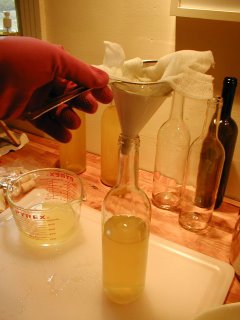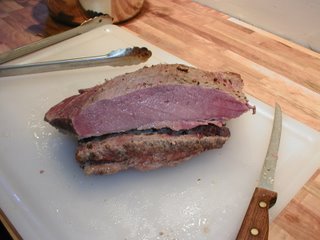
After a few days of searching S could not find a bitter orange. Instead of bitter oranges we ended up with sweet lemons. Meyer lemons are not not quite as tart as regular lemons and they have a sort of orangish finish.
So into they pot they go along with some regular oranges, sugar, a vanilla bean and the five to one ratio of wine and vodka. We'll see what happens in forty days.
This is S's batch; I hope she shares.
cheers.
27 March, 2006
Vin d'Orange
24 March, 2006
Vin de Pamplemousse

40 days ago I finally got around to working on a recipe that I have been holding on to since Fall 2004. As with the sausages and other cured delicacies, the Vin de Pamplemousse (grapefruit wine) rattles about my head as one of the essential ingredients for the elusive Mid-Summer's party. I will have one sometime (maybe this Summer) but until then I will keep practicing. Lillet, a French aparatif(a fortified wine with an orange essence), reminds me of the summer of 1998. We sat in a tiny walled green oasis, in Williamsburg, perfect in every way except for the stifling heat. We balanced ourselves with this smooth beverage poured over cracked ice with a slice of orange or lemon and we sat and we waited for nothing to happen.
Ah the salad days. In Fall 2004 the New York Times Magazine had an recipe for homemade Lillet, except since Seville Oranges (bitter oranges) are hard to come by in the US, it called for grapefruit. I was hooked, I just had to find the conviction.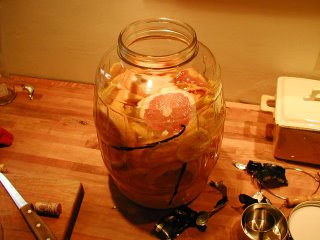
Five bottles of white, one bottle of vodka, six grapefruit, lemons, vanilla bean, sugar. To the basement for forty days.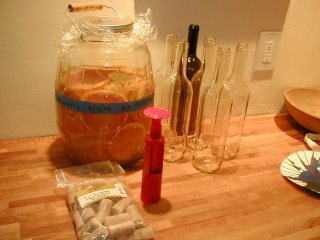
I got some corks and a corking thing at Bev-Art, up in Beverly. Strained the vin into the bottles and set the cork. I'll let them sit for at least another month.
The combination of citrus and vanilla gave off the aroma of bubble gum, and the taste finished with a very sharp grapefruit. We see how it is in the summer. But S could not wait. What I had left over from the bottling I chilled in a pitcher. After polishing off the pitcher (I helped) She declared this would be the drink of summer. Then she started thinking about vin d'orange: Chicago is a cosmopolitan Midwestern town, there had to be bitter oranges around here somewhere....Sounds like a project.
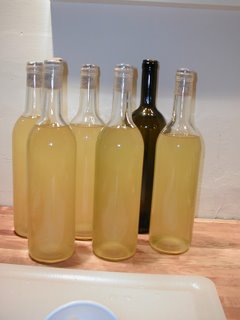
19 March, 2006
Into the bin
Tonight's menu, Rubens. The featured fermented guest, however will not make it. Mold took hold of the sauerkraut that I started two weeks back. I have to do a better job of keeping the cabbage completely submerged. I will start another batch tomorrow. Tonight's fill in: One can of Frank's Quality Kraut.
18 March, 2006
Saturday Corned Beef
S had an event Friday night, so while everyone else was out drowning the shamrock, me and the boys were home watching Harry Potter. Saturday became our St Patty's day and it started with the boys trying their luck on the iced sugar cookies.
 Next came the corned beef. After five days of curing, it was time to put on the boil. I was concerned because I had mished mashed two recipes together, the wet brine and the dry rub. I would not be able to tell until it was done whether or not it was cured too much or not enough. The color on the on the outside of the uncooked brisket looked purple to brown and the book did not provide any guidance on what it should look like. I was additionally worried about the cooking times: Both recipes said to cook "two or three hours or until fork tender." I find that direction rather vague. I will concede that since I "went off book," that my results were (very) far from guaranteed, but when it come to cooking time I always cook to temperature. I find cooking to internal temperature is the best way the have consistently good results. But remember kids, just like when your are navigating a supertanker into the Port of Houston, Use more than one chart. Triangulate between two thermometers and cooking time.
Next came the corned beef. After five days of curing, it was time to put on the boil. I was concerned because I had mished mashed two recipes together, the wet brine and the dry rub. I would not be able to tell until it was done whether or not it was cured too much or not enough. The color on the on the outside of the uncooked brisket looked purple to brown and the book did not provide any guidance on what it should look like. I was additionally worried about the cooking times: Both recipes said to cook "two or three hours or until fork tender." I find that direction rather vague. I will concede that since I "went off book," that my results were (very) far from guaranteed, but when it come to cooking time I always cook to temperature. I find cooking to internal temperature is the best way the have consistently good results. But remember kids, just like when your are navigating a supertanker into the Port of Houston, Use more than one chart. Triangulate between two thermometers and cooking time.
Anyway back to the Corned Beef. I looked around the web for a cooking temp and the closest I got was for a Pastrami on the Weber smoker. It suggested 160F. It took only ninety minutes to get to 160 and that was too quick. Besides it definitely was not fork tender. I slowed the oven down and let it go to about 188, another ninety minutes. The whole time I worried about what I was going to get but I also started to realize I did not know what I wanted to get. All I had hoped was that it would not be too salty and the color would be right.
But the smell. Last year I made boiled a corned beef (corned beef from the store) and cooking it smelled like corned beef. I remember when we ate it we thought mmm this is good corned beef, maybe a little salty, but tastes like every other corned beef. The corned beef today smelled different. The cloves and the allspice dominated the house. It smelled like Christmas. Now I am worried that I will have a piece of meat that tastes more like mulled wine than a Ruben.
As you can see from the picture below the brisket noticeably shrank. But it got thicker. The color, Boiled Brown.

So the moment of truth, I cut it into it by about a third and sampled. The color unbelievably even and red. And the taste, well it was worth all the worrying. The layers of flavor in the meat led me to understand how the each ingredient played an important role in the cure. I had expected salt to be the lead player in this medley with the chorus rounding out the flavor, but it was an ensemble piece( A Collective, to use the parlance of our times) where no single ingredient stood out. And it definitely tasted like corned beef.
Next time I will probably only cook it to 160. I strained the broth and used it to boil red potatoes, carrots, parsnips and cabbage. And lastly the Gravlaks...the simplest magic that yields such tasty fish.


15 March, 2006
Wednesday Gravlaks
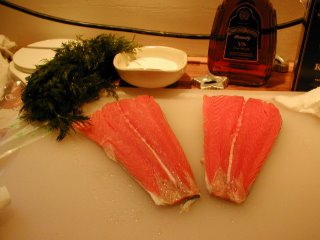
So I start worrying about some sort of appetizer for the St Patty's boiled dinner. Sure I'll have cabbage and carrots and potatoes and even a parsnip, but what's before that? Some cheese, some something....how about some cured fish. You may not find it on any pub menu, but I had a small piece of fish in the freezer so why not? This really started back in December when I saw New Scandinavian Cooking, on PBS. On the Christmas show they showed Gravlaks (ground fish?) as one of the traditional dishes. I was hooked. Since the recipe (from the New Scandinavian Cooking website) only called for six pounds (and I had seven)I chopped off the tail end and threw it in the freezer. This was my first time at curing anything so I was a little nervous. But Christmas morning the gravlaks turned out better than I could have imagined; it simply melted in your mouth. We also had an expert among the crowd that morning, our good friend from Finland was with us and she declared it the most wonderful Christmas miracle. She also showed me how to cut it right too.
So this is pretty simple: One part salt, two parts sugar, a handful of dill, a grinding of pepper and a splash of brandy. Cure for three days. Flip it daily.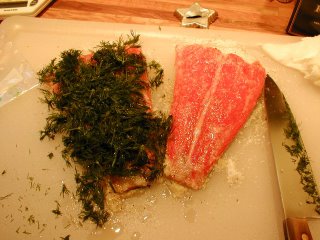 Now at Christmas time I thought that the lack of cold smoking would be noticeable when comparing the gravlaks to the smoked fish you get at the store. I was wrong; I did not miss it at all.
Now at Christmas time I thought that the lack of cold smoking would be noticeable when comparing the gravlaks to the smoked fish you get at the store. I was wrong; I did not miss it at all.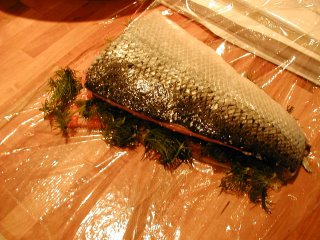 However I still want to smoke some salmon. Maybe this Summer for the Mid-Summer celebration. I have to build a cold smoker first, and that is going to have to wait until it gets a little warmer outside.
However I still want to smoke some salmon. Maybe this Summer for the Mid-Summer celebration. I have to build a cold smoker first, and that is going to have to wait until it gets a little warmer outside.
13 March, 2006
Monday Corned Beef
Time to make the Corned Beef. I started with a brisket weighing just under eight pounds. The recipe from the Charcuterie book called for simmering the salts and spices in four liters of water. I knew I would have to add more because the amounts called out were for a 5 lb cut of meat. Anyway combine everything together in a pot big enough to hold the brine and the beef. A pot big enough...I started imagining the meat floating about(certainly not laying flat) inside a stainless steel pot. I had already come to the conclusion that I was going to use a two gallon Ziploc for the curing(it worked perfectly for the bacon), but I was not going to fit a gallon-plus of brine and 7 pounds-plus of beef in to the suddenly shrinking 2 gallon Ziploc.
I realized that I wanted(and needed) to do a dry rub. This would make the process more similar (familiar) to dry rubs for barbecue and curing bacon. I looked at the corned beef recipe in The Best Recipe, by the editors of Cook's Illustrated magazine, and they use a dry rub process. So I was in luck. The main difference between the wet cure and the dry cure (other than the water) is that a lot less salt is used for the dry cure. The Charcuterie book claims that a wet brine does a better job of infusing the aromatics into the meat. The Best Recipe, reports the opposite. We will see.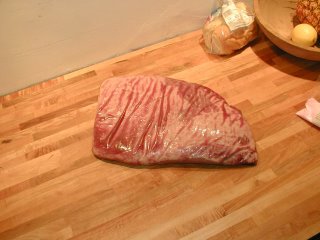
Eventhough it looks small in this picture, It is just under eight pounds.

The Basic Dry Cure (recipe from Charcuterie)on the right consists of Kosher Salt, pink salt (6.25% sodium nitrite, it is colored pink so it isn't mistaken for regular salt), and sugar. In the middle, Pickling Spice mixture from the Spice House.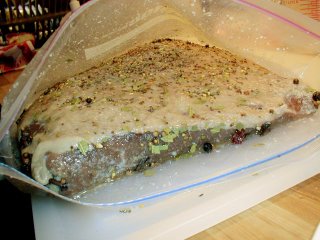
One Brisket rubbed and ready.
With a couple weights, the brisket goes into the fridge until Saturday. I'll flip it everyday.
Cheers.
12 March, 2006
Sunday Bratwurst
Unlike that past couple of weekends, I had not planned to make sausage. Yesterday we went to Chellberg Farm at the Indiana Dunes for the Maple Syrup Festival. There is not much to it, a couple of demonstrations of how they made syrup in the old days, a sugar shack, and some stumps into which the kids could drill holes. In the parking lot the Chesterton Lions Club were selling pancakes and Swedish Potato Sausages. It was a nice day, so why not a Sausage. After finishing a very delicious sausage I just started thinking about Bratwurst. Bratwurst Bratwurst Bratwurst. It is my farvorite sausage. I resolved to make Brats on Sunday. I just used what I had on hand, the other half of the pork shoulder from last week's production and the seasoning mix from the Spice House.

Here's the partially frozen pork shoulder. After cubing and seasoning, the meat is ready for the grinder.

The meat grinder attachment for the Kitchen-Aid does a pretty good job.

Time to make the sausage.
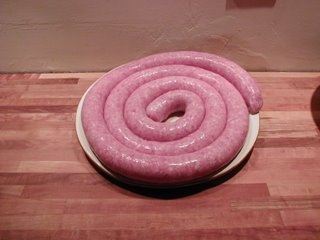

I poached the brats in St. Pauli Girl (it was on sale) and gave it a little char on the grill. It was a nice weekend.
Cheers.
06 March, 2006
Welcome to my little world
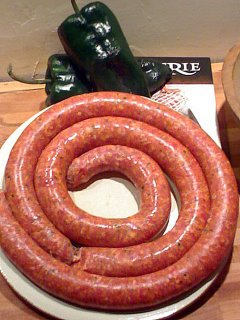
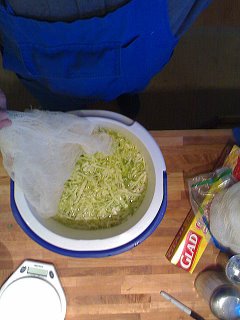
Welcome to my little world. I have set up this blog to keep you apprised of what I'm working on in the Kitchen. This week I made a spicy Italian Sausage and started a Sauerkraut. The Sausage was served on mashed potato with roasted poblano pepper. It turned out so nice that we even ate the piece I was saving for the neighbor. This second time I made sausage, the first being last weekend when I attempted a Bratwurst. It turned out okay, it was sort of a cross between a Brat and a Polish because I added garlic and some smoked pork belly (bacon). And since we are moving backwards in time, two weeks before the Brat experiment I cured my first pork belly. It sat in a brine cure for a week then I hot smoked it for three hours on the Weber Smoky Mountain (WSM). It turned out okay the neighbor said it needed more smoke.
So I guess that should get you caught up. I have been smoking and barbecuing in for the last five years (the WSM is my smoker of choice); but recently I everything changed when a good friend told me about the book, Charcuterie by Michael Ruhlman and Brian Polcyn. Now I am all about the Sausage, and working on cured meats. and so it goes.
A quick note on the second picture: The Sauerkraut should be ready on 17 March. It is salt, water and cabbage in a two gallon Igloo cooler sitting in the basement. The plan it use it for Rubens which will hopefully come from the left over St. Patty's corned beef. The corned beef? Well that's next week.
Cheers.
01 March, 2006
About MAC
Saucisson MAC is Andrew Conaway.
If you are what you eat then Andrew is a giant sausage. He has always cooked but after receiving a cookbook as a gift he became obsessed. The book, Charcuterie, by Ruhlman and Polcyn, showed him it was possible to make at home the artisanal sausages and pates one could find in a “gourmet” store. However the more he researched the history of charcuterie, Andrew began to realize that he had the flow of food backwards: Sausage recipes did not come from fancy shops, charcuterie evolved centuries ago in home kitchens as a method of preservation. While salting and curing is not as important in today’s home kitchen, having the knowledge is, the more you know about food the better you eat.
In 2006, He started the blog, Saucisson MAC. Through pictures and words Andrew has tried to communicate that you don’t need big kitchen of fancy gadgetry to produce fine food. He has tried to bring a bit of history into what he makes. But most importantly he has tried to show how food should bring together friends and family.
Andrew learned to cook from his parents and his grandparents, and he is lucky to been surrounded by friends who have been interested in preparing good food. His uncle is a chef in Anchorage AK, and his sister has a baking and pastry degree at Le Cordon Bleu, Paris. Andrew has a degree in English from The Ohio State University, and in 2009 after completing a certificate of professional cookery at Kendall College, Chicago, Andrew worked as a prep cook and kitchen manager at Three Floyds Brewpub. There learned a lot about beer, he cured a lot of bacon, and stuffed hundreds of pounds of sausage. Now his focus is on helping people cook better at home. He lives in south suburbs with his with wife and two children.
Now get back to work.

Cheers.

